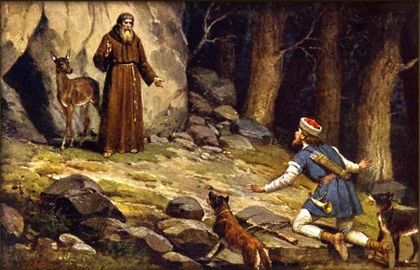April 1 (Eastern Orthodox liturgics)
From Wikipedia, the free encyclopedia
Mar. 31 - Eastern Orthodox liturgical calendar - Apr. 2

All fixed commemorations below celebrated on April 14 by Orthodox Churches on the Old Calendar.[note 1]
For April 1, Orthodox Churches on the Old Calendar commemorate the Saints listed on March 19.
Saints
- Saints Hermes and Theodora the martyrs (132)[1][2][note 2]
- Saint Melito of Sardis, Bishop of Sardis (177)[4]
- Martyrs Gerontius and Basilides (3rd century)[4][5][note 3]
- Saints Alexander, Dionysius, Ingeniani, Panteros (or Pantainos), Parthenios and Saturninus the Martyrs.[6][note 4]
- Martyr Polynikos.[7]
- Righteous Achaz (Ahaz)[8][note 5]
- Saint Mary of Egypt (c. 421)[4][9][10]
- Saint Makarios of Pelekete, Abbot of Pelekete monastery (820)[4][11][12][note 6]
- Saint Procopius of Sázava, Abbot of Sázava in Bohemia (1053)[4][13] (see also: July 4 - West)
Pre-Schism Western saints
- Venantius, a Dalmatian bishop whose relics were brought from Spalato to Rome in 641 (c. 255)[3][13]
- Saint Walric (Walericus, Valéry), Abbot of Leuconay (Saint-Valery-sur-Somme) (622)[13][14][note 7]
- Saints Caidoc and Fricor (Adrian), Welsh missionaries (7th century)[13][15][note 8]
- Saint Dodolinus of Vienne, Bishop of Vienne in the Dauphiné in France (7th century)[13]
- Saint Cellach (Cellach mac Congaile), Archbishop of Armagh in Ireland, previously the Abbot of Iona in Scotland and founder of the Monastery of Kells (815)[13][17]
Post-Schism Orthodox saints
- Saint John Shavteli of Salosi (John of Black Mountain), Georgia (12th-13th century)[18][19]
- Saint Eulogius of Salosi, Georgia, (Eulogius the Prophet), Fool-for-Christ (12th-13th century)[20]
- Martyr Abraham of Bulgaria, on the Volga, Wonderworker of Vladimir (1229)[4][21][22]
- Saint Gerontius of the Kiev Caves, Canonarch of the Kiev Caves (14th century)[4][23][24]
- Saint Euthymius the Wonderworker, Archimandrite of Suzdal (1404)[4][25][26]
- Saint Pachomius (Romansky), Archbishop of Roman and Galați, Moldavia, and monk of the Kiev Caves (1724)[4][27][note 9] (see also: April 14 - Romanian)
- Saint Barsanuphius of Optina, Elder (1913)[4][29][30]
New martyrs and confessors
Icon gallery
- St. Mary of Egypt. Russian icon, 19th century
- St. Procopius of Sázava.
- St. Abraham of Bulgaria.
- New Hieromartyr Sergius (Zavarin), Archpriest, of Yaroslavl.
- New Hiero-confessor Schema-bishop Macarius (Vasiliev).
Notes
- The notation Old Style or (OS) is sometimes used to indicate a date in the Julian Calendar (which is used by churches on the ii"Old Calendar"). The notation New Style or (NS), indicates a date in the Revised Julian calendar (which is used by churches on the "New Calendar").
- "AT Rome, the passion of St. Theodora, sister of the illustrious martyr Hermes, who underwent martyrdom in the time of the emperor Adrian, under the judge Aurelian, and was buried by the side of her brother, on the Salarian road, a short distance from the city."[3]
- A church dedicated to Martyr Gerontius existed in Constantinople until the end of the 14th century.
- As indicated in the Martyrologium Hieronymianum.
- Holy Righteous Ahaz died in peace. It is not known where and when.
- The Irishmen Caidoc and Fricor evangelized the country of the Morini in Picardy, northern France, beginning about 622. Among the souls they won for Christ was the nobleman Riquier (Saint Ricarius), who intervened when some locals to offense to their preaching and took them into his home. Riquier became a fervent Christian, who engaged in penitential austerities and eventually was ordained. In 625, Riquier founded Centula based on the Rule of Columbanus[broken anchor], another Irishman. Their relics are still venerated at the parish church of Saint-Riquier in the diocese of Amiens, although they rested in Centula until the 17th century. Saints Caidoc and Fricor joined Riquier's community and remained there until they were buried in Saint Riquier's church.[16]
- St. Pachomius was a Romanian bishop who was very devoted to the spirituality of St Paisius Velichkovsky and to the Saints of the Kiev Caves Lavra where he asked to spend his final days and as entombed at the Holy Dormition Lavra. He was glorified by the Romanian Orthodox Church in 2006 and his name was then added to the Ukrainian Orthodox Calendar.[28]
- See: (in Russian) Заварин, Сергей Константинович. Википедии. (Russian Wikipedia).
- See: (in Russian) Макарий (Васильев). Википедии. (Russian Wikipedia).
References
Sources
Wikiwand - on
Seamless Wikipedia browsing. On steroids.





